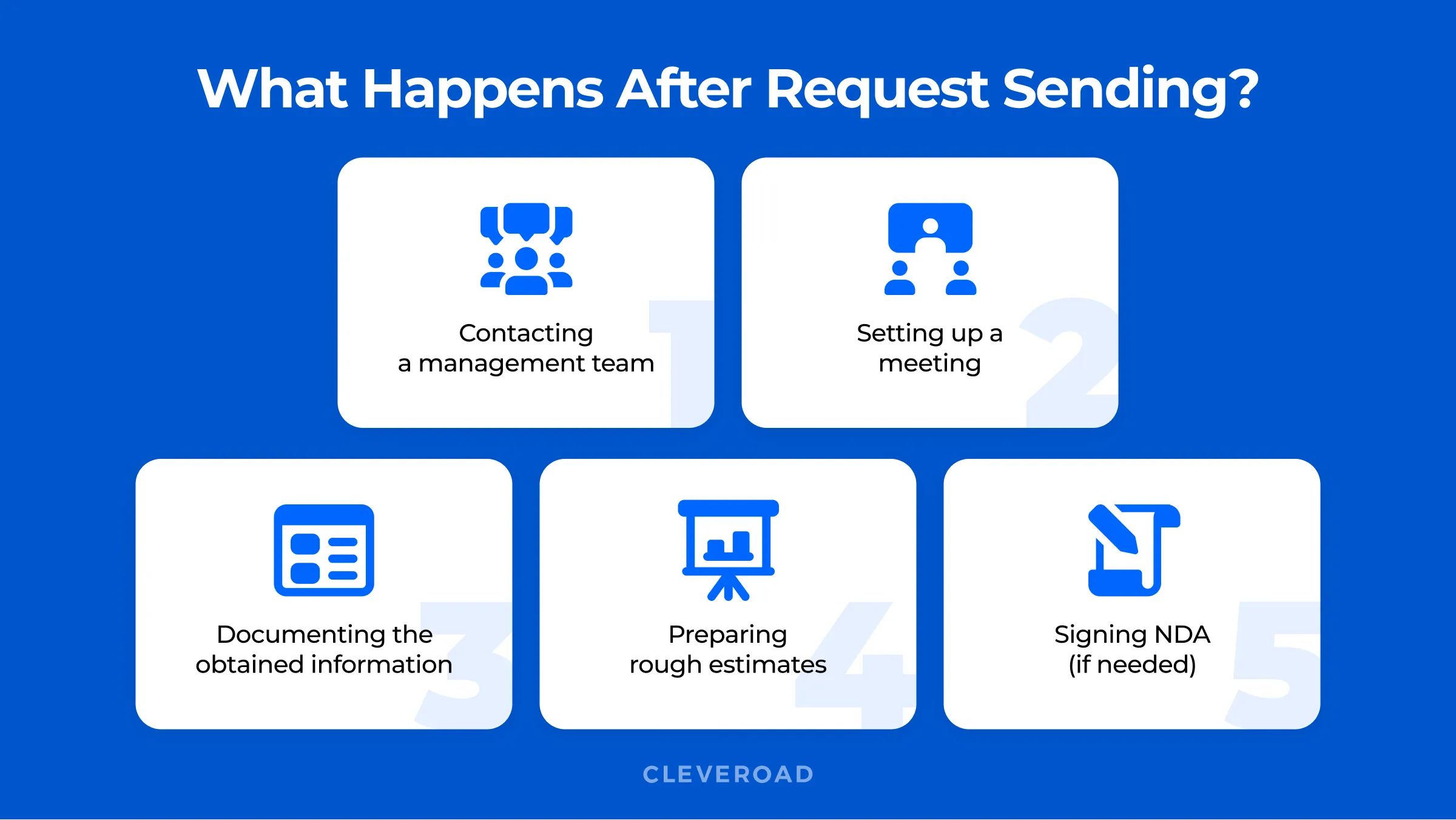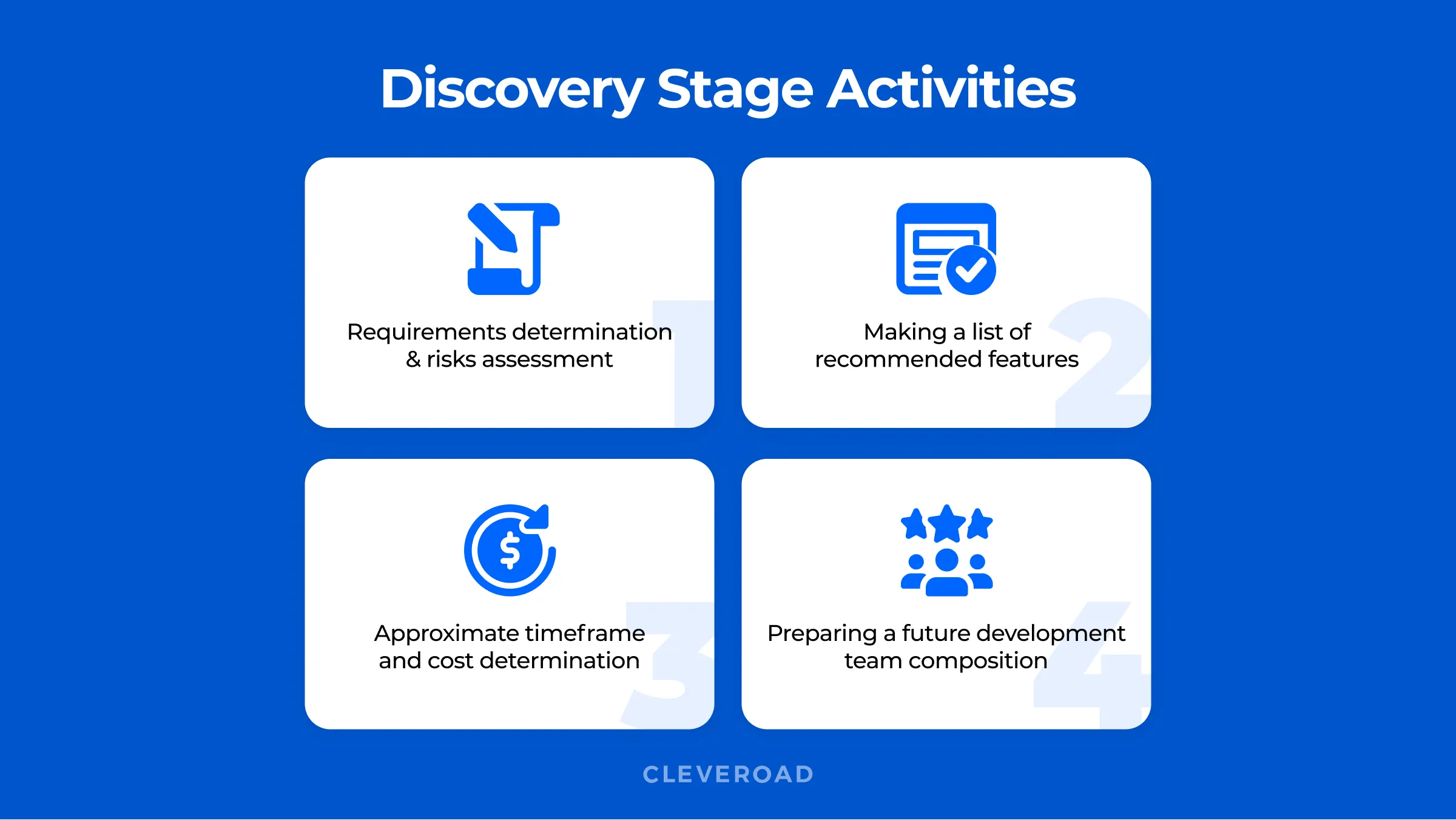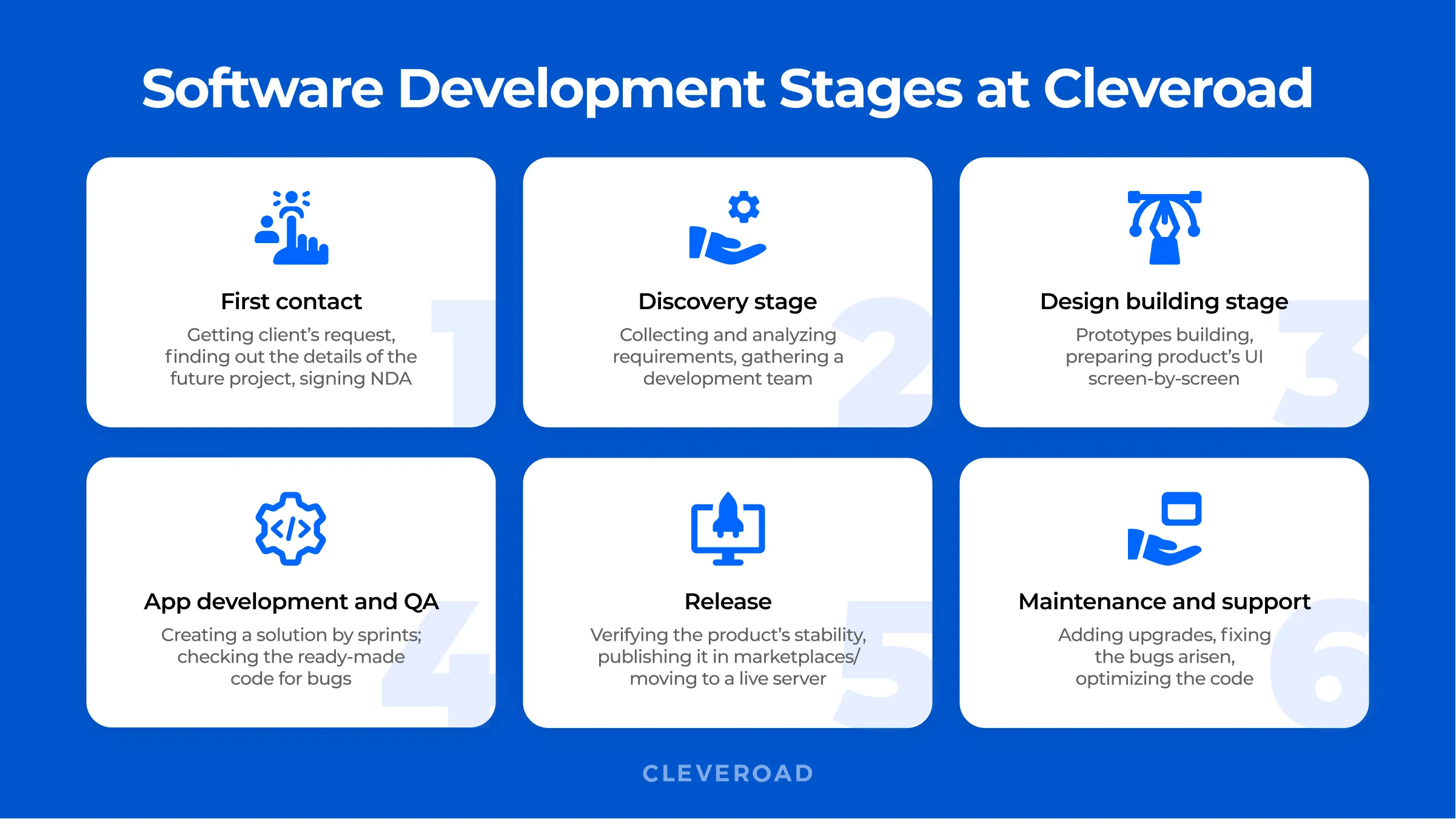How We Coordinate Our Customers When Building Solutions at Cleveroad
Updated 18 Aug 2023
7 Min
5139 Views
Companies from different spheres of activity have their own approaches to the work they do. Being involved in the sphere of IT, Cleveroad has its own techniques related to software development process and coordination of our customers.
Having years of experience we have optimized these processes in a way allowing us to build your ideas even faster and more convenient for you. In this article, we will tell you more about our company's approach to the development process.
Step 1. Everything starts with a request
Submitting a request on our website, you send a message directly to our management team, who will contact you within 24 hours.
Then, we set up a meeting to have a more in-depth discussion about your project and gather needs. You'll be asked about some clarifying questions intended to get as many information as possible. Among frequently asked questions we can single out ones related to provisional dates, features, target countries & audience, business model etc.
All the information we get will be documented. Based on these documents, we make a list of features that is furtherly sent to the team for app development for estimation. They (namely, our business analysts and engineers) generate an approximate estimate after analyzing the project needs and business goals as well as other gathered information.
After that, we sign an NDA to maintain secrecy (per client's request) and go on to the next level.

What's happening after the request
Step 2. Discovery stage
The main purpose of this stage is to gather your needs, such as platforms to cover, features to include, or third-party services to integrate (e.g., Stripe or Google Maps). We'll consider below more information about it.
Our business analysts (BA) research project requirements, draft new papers or revise existing ones, assess risks, and organize meetings to discuss business needs and user/tech requirements.
Then, the Solution Architect looks through the list and suggests which features to remove or maintain in order to get the project up and running faster — but the final decision is always yours.
Our team makes an approximate estimate of the time it will take to build each feature, including the minimum and maximum times.
According to your business needs, we gather a future software development team that will help you build your product. It may include iOS, Android, web developers, UI/UX designers, QA engineers, or DevOps engineers.

Discovery stage activities at Cleveroad
During that time, the client works with our project managers who write requirements and user stories for the project. After the client confirms the correspondence of the obtained materials to the initial project's idea, we transfer the project to our design team.
Designers work on wireframes, which are schematic representations of a user interface. After preparation, they need to be approved by the customer in order to move the development process forward. BAs in their turn, develop a specification that explains each feature and addresses technical considerations. Both processes are running at the same time.
A complete estimate of product development expenses by platforms is prepared by BAs, developers, and designers. Finally, if you agree with the figures and terms, we will sign a development contract.
Step 3. Making a Design for the Upcoming Solution
If you begin the software development process with our discovery phase, you may have already approved the wireframes and chosen your product's visual design.
UI/UX designers produce a prototype before coders go to work. It's based on the wireframes that were drawn up throughout the discovery process. The team starts with a design concept and then builds the user interface for a product screen by screen.
Do you want to learn more about the design process? Learn what techniques we use at Cleveroad to get the perfect design
Screens and their variations are prepared by our UI/UX designers. We also generate a style guide with all of the information that designers and developers may need, such as colors, gradients, and fonts.
After you've approved our work, the UI/UX designer hands over the project to the developers and becomes a supporter.
Step 4. Development and Quality Assurance
At Cleveroad, we use the Scrum framework as part of our Agile development approach. We build software in sprints, which are two-week intervals for a team to finish a specific amount of work.
Do you want to learn more about the role of agile software development methodologies in our company? Read how we create software at Cleveroad
Each sprint begins with a planning meeting and ends up with the delivery of a stable, functional product or feature. The customer and development team agree on the work scope for the following two weeks as well as the features that will be developed throughout each sprint.
The needed features are implemented by the development team. You may work with a variety of tech professionals, such as iOS, Android, or web developers, depending on the project (front-end and back-end).
Then QA engineers examine the functionality generated during each sprint and work on a project until it is released. They test the backend as well as the frontend, and then provide reports for software engineers to use in troubleshooting.
Why is testing so important? Get the answer for this and many other questions in our related article
When the team has completed all sprints, QA begins regression testing. They test on all platforms and functionalities, as well as stress testing if necessary. That is, they examine how the program performs under tremendous pressure in order to identify its stumbling blocks.
Step 5. Release
The team is ready to deploy the product after regression testing and resolving all QA concerns. To begin, the QA team conducts smoke tests to determine whether or not the product is stable. Developers must create hotfixes if any flaws are discovered.
We assist with the launching of your software on the AppStore or Google Play on the day of the release. If it's a web solution, we move it to the live server.
Once you're satisfied with the outcome, the team will hand over the project materials to you.
We pass over all of the following deliverables to you:
- Specification
- Design
- Change request/project plan/risk register
- Quality Assurance Register
- Additional project files that are useful
- Admin panel, website link, etc.
Step 6. Maintenance & Support
Our collaboration does not come to an end after the program is released. We may keep working on the program to make numerous modifications based on user input and maintain your solution with new features and upgrades.
The team will perform:
- An error correction
- Improvements in performance and stability
- A code optimization, etc.

Cleveroad - stages of software development process
Wrapping Up
Cleveroad is a professional software development company from Ukraine, Eastern Europe. We assist startups, small businesses, and large corporations in achieving their objectives and bringing ambitious ideas to reality for 10+ years.
We specialize in a wide variety of IT services and bespoke software solutions. They improve workflow efficiency, address business issues, and aid in the acquisition of competitive advantages. Cooperating with us, you'll obtain:
- An initial project estimate for free, with no hidden costs or fees from our Sales Managers
- A complimentary consultation with one of our Business Analysts or Project Managers
- Non-disclosure agreements (NDAs) signing per request
- Creating software from scratch, upgrading it, or modernizing legacy systems
- A team seamlessly fitting into established workflows
- Assurance and control of product quality at all stages
- Post-release support, maintenance, and advertising services.
If there are some questions left uncovered - contact our managers to get your free consultation. Let's work together and succeed!
Submitting a request on our website, you send a message directly to our management team, who will contact you within 24 hours.
Then, we set up a meeting to have a more in-depth discussion about your project and gather needs. You'll be asked about some clarifying questions intended to get as many information as possible. Among frequently asked questions we can single out ones related to provisional dates, features, target countries & audience, business model etc.
According to your business needs, we gather a future software development team that to help you build your product on a discovery stage. It may include iOS, Android, web developers, UI/UX designers, QA engineers, or DevOps engineers.
At Cleveroad, we use the Scrum framework as part of our Agile development approach. We build software in sprints, which are two-week intervals for a team to finish a specific amount of work.

Evgeniy Altynpara is a CTO and member of the Forbes Councils’ community of tech professionals. He is an expert in software development and technological entrepreneurship and has 10+years of experience in digital transformation consulting in Healthcare, FinTech, Supply Chain and Logistics
Give us your impressions about this article
Give us your impressions about this article